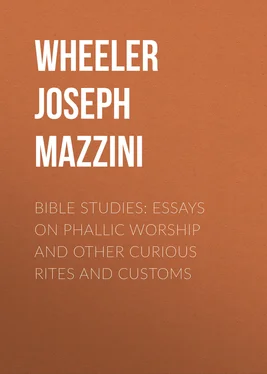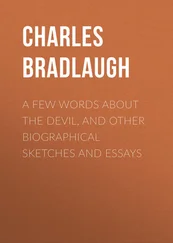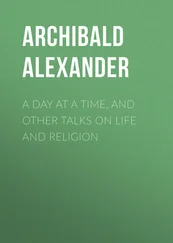Joseph Wheeler - Bible Studies - Essays on Phallic Worship and Other Curious Rites and Customs
Здесь есть возможность читать онлайн «Joseph Wheeler - Bible Studies - Essays on Phallic Worship and Other Curious Rites and Customs» — ознакомительный отрывок электронной книги совершенно бесплатно, а после прочтения отрывка купить полную версию. В некоторых случаях можно слушать аудио, скачать через торрент в формате fb2 и присутствует краткое содержание. Жанр: foreign_prose, foreign_religion, Философия, foreign_psychology, foreign_antique, на английском языке. Описание произведения, (предисловие) а так же отзывы посетителей доступны на портале библиотеки ЛибКат.
- Название:Bible Studies: Essays on Phallic Worship and Other Curious Rites and Customs
- Автор:
- Жанр:
- Год:неизвестен
- ISBN:нет данных
- Рейтинг книги:4 / 5. Голосов: 1
-
Избранное:Добавить в избранное
- Отзывы:
-
Ваша оценка:
- 80
- 1
- 2
- 3
- 4
- 5
Bible Studies: Essays on Phallic Worship and Other Curious Rites and Customs: краткое содержание, описание и аннотация
Предлагаем к чтению аннотацию, описание, краткое содержание или предисловие (зависит от того, что написал сам автор книги «Bible Studies: Essays on Phallic Worship and Other Curious Rites and Customs»). Если вы не нашли необходимую информацию о книге — напишите в комментариях, мы постараемся отыскать её.
Bible Studies: Essays on Phallic Worship and Other Curious Rites and Customs — читать онлайн ознакомительный отрывок
Ниже представлен текст книги, разбитый по страницам. Система сохранения места последней прочитанной страницы, позволяет с удобством читать онлайн бесплатно книгу «Bible Studies: Essays on Phallic Worship and Other Curious Rites and Customs», без необходимости каждый раз заново искать на чём Вы остановились. Поставьте закладку, и сможете в любой момент перейти на страницу, на которой закончили чтение.
Интервал:
Закладка:
Mr. Grant Allen, in an article on Sacred Stones in the Fortnightly Review , Jan., 1890, says:
"Samuel judged Israel every year at Bethel, the place of Jacob's sacred pillar; at Gilgal, the place where Joshua's twelve stones were set up; and at Mizpeh, where stood the cairn surmounted by the pillars of Laban's servant. He, himself, 'took a stone and set it up between Mizpeh and Shen'; and its very name, Ebenezer, 'the stone of help,' shows that it was originally worshipped before proceeding on an expedition, though the Jehovistic gloss, 'saying Hitherto the Lord hath helped us,' does its best, of course, to obscure the real meaning. It was to the stone circle of Gilgal that Samuel directed Saul to go down, saying; 'I will come down unto thee, to offer burnt offerings, and to sacrifice sacrifices of peace offerings.' It was at the cairn of Mizpeh that Saul was chosen king; and after the victory over the Ammonites, Saul went once more to the great Stonehenge at Gilgal to 'review the kingdom,' and 'There they made Saul king before Jahveh in Gilgal; and there they sacrificed sacrifices of peace offerings before Jahyeh.'"
This last passage, as Mr. Allen points out, is very instructive, as showing that in the opinion of the writer, Jahveh was then domiciled at Gilgal.
M. Soury, in his note to chap. ii. of his Religion of Israel , says: "It is needful to point out, with M. Schrader, that the most ancient Babylonian inscriptions in the Accadian tongues, those of Urukh and of Ur Kasdim, preserved in the British Museum, were engraved on clay phalii. We have here the origin of the usages and customs of religion so long followed among the Oanaanites and Hebrews (Y. Movers, Die Phonizer , I., 591, et passim )."
In the old hymn embodied in Deut. xxxii., God is frequently called Tsur , "The Rock which begat thee," etc. Major-General Forlong believes "that the Jews had a Phallus or phallic symbol in their 'Ark of the Testimony' or Ark of the Eduth, a word which I hold tries to veil the real objects" ( Rivers of Life , vol. i., p. 149). He does not scruple to say this was "the real God of the Jews; that God of the Ark or the Testimony, but surely not of Europe" (vol. i., p. 169). This contention is forcibly suggested by the picture of the Egyptian Ark found in Dr. Smith's Bible Dictionary , art.
"Ark of the Covenant." The Ark of the Testimony, or significant thing, the tabernacle of the testimony and the veil of the testimony alluded to in Exodus are never mentioned in Deuteronomy. The Rev. T. Wilson, in his Archaeological Dictionary , art. "Sanctum," observes that "the Ark of the Covenant, which was the greatest ornament of the first temple, was wanting in the second, but a stone of three inches thick, it is said, supplied its place, which they [the Jews] further assert is still in the Mahommedan mosque called the temple of the Stone , which is erected where the Temple of Jerusalem stood." This forcibly suggests that the nature of the "God in the box" which the Jews carried about with them was similar to that carried in the processions of Osiris and Dionysos. According to 1 Kings viii. 9 the Ark contained two stones, but the much later writer of Heb. ix. 4 makes it contain the golden pot with manna, Aaron's rod, and the tables of the covenant.
Mr. Sellon, in the papers of the Anthropological Society of London, 1863-4, p. 327, argues: "There would also now appear good ground for believing that the ark of the covenant, held so sacred by the Jews, contained nothing more nor less than a phallus, the ark being the type of the Argha or Yoni (Linga worship) of India." Hargrave Jennings ( Phallicism , p. 67) says: "We know from the Jewish records that the ark contained a table of stone.... That stone was phallic, and yet identical with the sacred name Jehovah, which, written in unpointed Hebrew with four letters, is JEVE, or JHVH (the H being merely an aspirate and the same as E). This process leaves us the two letters I and V (in another form, U); then, if we place the I in the V, we have the 'Holy of Holies'; we also have the Linga and Yoni and Argha of the Hindus, the Isvara and 'Supreme Lord'; and here we have the whole secret of its mystic and arc-celestial import confirmed in itself by being identical with the Ling-yoni of the Ark of the Covenant."
In Hosea, who finds it quite natural that the Lord should tell him "Go take unto thee a wife of whoredoms," we find the Lord called his zakar (translated memorial, xii. 5). In the same prophet we read that Jahveh declares thou shalt call me Ishi (my husband); and shalt no more call me Baali (ii. 16). Again he says to his people "I am your husband" (Hosea iii. 14); "Thy maker is thine husband; Jahveh Sabaoth is his name" (Isaiah liv. 5). I was an husband to them, saith Jahveh (Jer. xxxi. 32. See also Jer. iii. 20 and Ezek. xvi. 32). God even does not scruple to represent himself in Ezekiel xxiii. as the husband of two adulterous sisters. Taking to other deities is continually called whoring and adultery. See Exod. xxxiv. 15, 16; Lev. xx. 5; Num. xxv. 1-3; Deut. xxxi. 16; xxxii. 16-21; Jud. ii. 17; viii. 27; 1 Chron. v. 25; Ps. lxxiii. 27; cvi. 39; Jer. iii. 1, 2, 6; Ezek. xvi. 15, 17; xxiii. 3; Hos. i. 2; ii. 4, 5; iv. 13, 15; v. 3, 4; ix. 7. In the Wisdom of Solomon (xiv. 12), we read: "For the devising of idols was the beginning of spiritual fornication, and the invention of them the corruption of life." Here the word "spiritual" is deliberately inserted to pervert the meaning. Let any one reflect how such coarse expressions could continually be used unless the writers were used to phallic worship. Further consider the narrative in Numbers xxxi., where the Lord takes a maiden tribute out of 32,000 girls, who must all have been examined. Vestal virgins and nuns are all consecrated like the kadeshim to the god, and the god is personified by the priest. In this sense phallicism is the key of all the creeds.
That some remnants of phallicism may be traced even in Christianity, will be evident to the readers of Anacalypsis , by Godfrey Higgins; Ancient Faiths Embodied in Ancient Names , by Dr. Thomas Inman, and Ancient Pagan and Modern Christian Symbolism Exposed and Explained , by the same author; the valuable Rivers of Life , by Major-General Forlong; a little book on Idolomania , by "Investigator Abhorrens"; and another on The Masculine Cross , by Sha Rocco (New York, 1874). The sign of the cross, certainly long pre-Christian in the Egyptian sign for life, is specially dealt with in the last two works. In fig. 7 we see the connection of the Egyptian tau with the Hermæ. Of fig. 8 General Forlong ( Rivers of Life , vol i., p 65) says: "The Samaritan cross, which they stamped on their coins, was No. 1, but the Norseman preferred No. 2 (the circle and four stout arms of equal size and weight), and called it Tor's hammer. It is somewhat like No. 3, which the Greek Christians early adopted, though this is more decidedly phallic, and shows clearly the meaning so much insisted on by some writers as to all meeting in the centre."
The custom of eating fish on Friday ( Dies Veneris ) is considered a survival of the days when a peculiar sexual signification was given to the fish, which has such a prominent place in Christian symbolism. Fig. 9 illustrates the origin of the bishop's mitre.
The vescica piscis , or fish's bladder (fig. 10), is a well-known ecclesiastical emblem of the virgin, often used in church windows, seals, etc. The symbol is equally known in India. Its real nature is shown in fig. 11, discovered by Layard at Nineveh, depicting its worshipper seated on a lotus. The vescica piscis is conspicuously displayed in fig. 12, copied from a Rosary of the Blessed Virgin, printed at Venice 1582, with the license from the Inquisition, in which the Holy Dove darts his ray, fecundating the Holy Virgin. Many instances of Christ in an elliptical aureole may be seen in Didron's Christian Iconography , fig. 71, p. 281, vol. i. strikingly resembles our figure.
Читать дальшеИнтервал:
Закладка:
Похожие книги на «Bible Studies: Essays on Phallic Worship and Other Curious Rites and Customs»
Представляем Вашему вниманию похожие книги на «Bible Studies: Essays on Phallic Worship and Other Curious Rites and Customs» списком для выбора. Мы отобрали схожую по названию и смыслу литературу в надежде предоставить читателям больше вариантов отыскать новые, интересные, ещё непрочитанные произведения.
Обсуждение, отзывы о книге «Bible Studies: Essays on Phallic Worship and Other Curious Rites and Customs» и просто собственные мнения читателей. Оставьте ваши комментарии, напишите, что Вы думаете о произведении, его смысле или главных героях. Укажите что конкретно понравилось, а что нет, и почему Вы так считаете.












